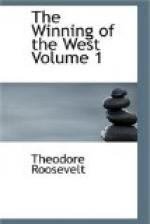32. See James Smith, passim.
33. Among the later Campbell MSS. are a number of copies of papers containing traditional accounts of this battle. They are mostly very incorrect, both as to the numbers and losses of the Indians and whites, and as to the battle itself very little help can be derived from them.
34. Campbell MSS.
35. Campell MSS.
36. Tennessee historians sometimes call it the battle of Long Island; which confuses it with Washington’s defeat of about the same date.
37. The captains’ report says the Indians were “not inferior” in numbers; they probably put them at a maximum. Haywood and all later writers greatly exaggerate the Indian numbers; as also their losses, which are commonly placed at “over 40,” of “26 being left dead on the ground.” In reality only 13 were so left; but in the various skirmishes on the Watauga about this time, from the middle of July to the middle of August, the backwoodsmen took in all 26 scalps, and one prisoner ("American Archives,” 5th Series, I., 973). This is probably the origin of the “26 dead” story; the “over 40” being merely a flourish. Ramsey gives a story about Isaac Shelby rallying the whites to victory, and later writers of course follow and embellish this; but Shelby’s MS. autobiography (see copy in Col. Durrett’s library at Louisville) not only makes no mention of the battle, but states that Shelby was at this time in Kentucky; he came back in August or September, and so was hundreds of miles from the place when the battle occurred. Ramsey gives a number of anecdotes of ferocious personal encounters that took place during the battle. Some of them are of very doubtful value—for instance that of the man who killed six of the most daring Indians himself (the total number killed being only thirteen), and the account of the Indians all retreating when they saw another of their champions vanquished. The climax of absurdity is reached by a recent writer, Mr. Kirke, who, after embodying in his account all the errors of his predecessors and adding several others on his own responsibility, winds up by stating that “two hundred and ten men under Sevier and [Isaac] Shelby ... beat back ... fifteen thousand Indians.” These numbers can only be reached by comparing an exaggerated estimate of all the Cherokees, men, women, and children, with the white men encountered by a very small proportion of the red warriors in the first two skirmishes. Moreover, as already shown, Shelby was nowhere near the scene of conflict, and Sevier was acting as Robertson’s subaltern.
38. Another fort, called Fort Lee, had been previously held by Sevier but had been abandoned; see Phelan, p. 42.
39. “American Archives,” 5th Series, I., 973; 500 women and children.
40. Campbell MSS. Haywood says that the first help came from Evan Shelby; Col. Russell, at Baton’s Station proving dilatory. In the Campbell MSS. are some late letters written by sons of the Captain Campbell who took part in the Island Flats fight, denying this statement.




